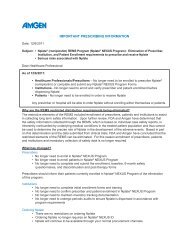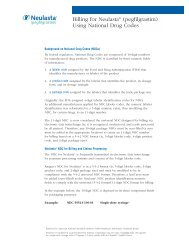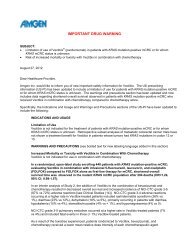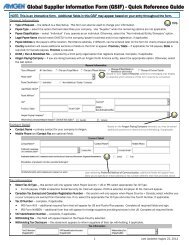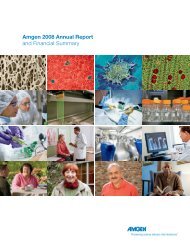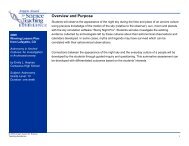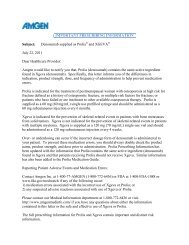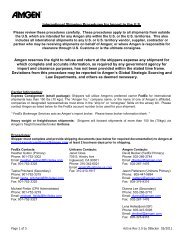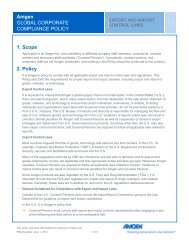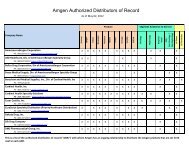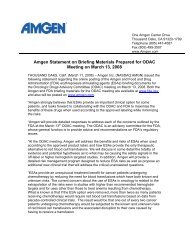Re: National Coverage Analysis for Erythropoiesis ... - Amgen
Re: National Coverage Analysis for Erythropoiesis ... - Amgen
Re: National Coverage Analysis for Erythropoiesis ... - Amgen
Create successful ePaper yourself
Turn your PDF publications into a flip-book with our unique Google optimized e-Paper software.
July 16, 2010<br />
Louis Jacques, MD<br />
Director, <strong>Coverage</strong> and <strong>Analysis</strong> Group<br />
Office of Clinical Standards and Quality<br />
Centers <strong>for</strong> Medicare & Medicaid Services<br />
C1-11-08<br />
7500 Security Boulevard<br />
Baltimore, MD 21244<br />
Josh Ofman, MD, MSHS<br />
Vice President<br />
<strong>Re</strong>: <strong>National</strong> <strong>Coverage</strong> <strong>Analysis</strong> <strong>for</strong> <strong>Erythropoiesis</strong> Stimulating Agents <strong>for</strong> Treatment of<br />
Anemia in Adults with Chronic Kidney Disease including patients on dialysis and<br />
patients not on dialysis (CAG-00413N)<br />
Dear Dr. Jacques:<br />
<strong>Amgen</strong> Inc. (<strong>Amgen</strong>) is pleased to submit comments on the CMS <strong>National</strong> <strong>Coverage</strong> <strong>Analysis</strong><br />
(NCA) <strong>for</strong> <strong>Erythropoiesis</strong> Stimulating Agents (ESAs) in treating chronic kidney disease (CKD)<br />
and dialysis-related anemia (CAG-00413N) that was announced on June 16, 2010. ESAs are<br />
indicated <strong>for</strong> the treatment of anemia associated with chronic renal failure (CRF), including<br />
patients on and not on dialysis (NOD).<br />
As a science-based, patient-care driven company, <strong>Amgen</strong> is committed to using science and<br />
innovation to dramatically improve people’s lives and is vitally interested in improving access to<br />
innovative drugs and biologicals <strong>for</strong> Medicare beneficiaries. The highest levels of patient safety<br />
are an important part of this commitment throughout the lifecycle of our products. As such, we<br />
communicate proactively with the US Food and Drug Administration (FDA) and the Centers <strong>for</strong><br />
Medicare and Medicaid Services (CMS), as well as the nephrology community regarding the
<strong>Amgen</strong> Comments on CAG-00413N<br />
July 16, 2010<br />
Page 2 of 15<br />
safe and effective use of our products. <strong>Amgen</strong> remains steadfast in our commitment to working<br />
with all stakeholders to provide objective, rigorous, and evidence-based in<strong>for</strong>mation.<br />
We are attentive to the concerns of CMS regarding the appropriate use of this class of products.<br />
On March 24, 2010 <strong>Amgen</strong> participated in the Medicare Evidence Development and <strong>Coverage</strong><br />
Advisory Committee (MEDCAC) meeting regarding the use of ESAs in treating anemia related<br />
to chronic kidney disease (CKD). The MEDCAC meeting served as a valuable <strong>for</strong>um to both<br />
explore and better understand the available clinical evidence regarding the treatment of anemia<br />
related to chronic kidney disease. Following the March MEDCAC meeting, CMS opened an<br />
NCA and requested public comments about the evidence regarding the effects of ESAs on<br />
health outcomes in adult CKD patients, both on dialysis and not on dialysis. Below, we provide<br />
a brief overview of evidence supporting the benefit:risk profile <strong>for</strong> ESAs, discuss key points<br />
underlying the available evidence regarding the effects of ESAs on health outcomes, and clarify<br />
misrepresentations and misinterpretations of the available evidence regarding the use of ESAs<br />
raised in the MEDCAC process. In addition, we are supplying CMS with a detailed summary of<br />
the current clinical evidence relevant to the agency’s NCA (see Appendix A).<br />
In determining coverage policy <strong>for</strong> ESAs, we urge CMS to ensure that policy decisions are<br />
evidence-based and aligned with FDA-approved product labeling, and avoid coverage policies<br />
that are based on unsupported or inappropriate extrapolations of data from existing trials and<br />
studies to clinical practice situations that may differ substantially. In 2007 the benefits and risks<br />
of ESA therapy <strong>for</strong> the anemia of CKD were discussed at a joint meeting of FDA’s<br />
Cardiovascular and <strong>Re</strong>nal Drugs Advisory Committee (CRDAC) and Drug Safety and Risk<br />
Management Advisory Committee (DSRMAC). An examination of the optimal use of ESAs was<br />
conducted and product labeling was changed to reflect these deliberations. Since 2007, the<br />
only new clinical trial in<strong>for</strong>mation on the use of ESAs in CKD is from the recently reported Trial<br />
to <strong>Re</strong>duce Cardiovascular Events with Aranesp Therapy (TREAT) study; FDA has signaled its<br />
intention to proceed with a comprehensive review of TREAT and other evidence later this year.<br />
<strong>Amgen</strong> looks <strong>for</strong>ward to this 2010 FDA CRDAC meeting, where the full range of evidence on<br />
ESA benefits and risks can be discussed. The CRDAC deliberations may in<strong>for</strong>m changes to<br />
product labeling, and thus, any deliberation of coverage policies should ultimately be consistent<br />
with product labeling.
<strong>Amgen</strong> Comments on CAG-00413N<br />
July 16, 2010<br />
Page 3 of 15<br />
I. EXECUTIVE SUMMARY<br />
ESAs are used to elevate or maintain red blood cell (RBC) levels (as manifested by hemoglobin<br />
or hematocrit determinations) and to decrease the need <strong>for</strong> RBC transfusions. EPOGEN ® and<br />
Aranesp ® are approved <strong>for</strong> the treatment of anemia associated with CRF, which includes<br />
patients receiving and not receiving dialysis. <strong>Amgen</strong>’s view on the appropriate balance of<br />
benefits and risks of ESAs in CKD was presented at the March 24, 2010 MEDCAC meeting.<br />
<strong>Amgen</strong> submitted a briefing book that describes the risks and benefits of ESA treatment <strong>for</strong><br />
CKD patients (Appendix A).<br />
This cover letter will summarize the key points from the briefing book and outlines <strong>Amgen</strong>’s<br />
position that was presented at the recent CMS MEDCAC meeting. Chronic kidney disease<br />
patients on dialysis and not on dialysis (CKD-NOD) are distinctly different, and have a different<br />
benefit:risk profile as it relates to the criticality of transfusion avoidance, and thus ESA therapy<br />
<strong>for</strong> anemia management. Despite these differences, both patient populations demonstrate<br />
intrinsic hemoglobin variability necessitating the use of a hemoglobin range <strong>for</strong> clinical<br />
management, where ESA’s are administered to maximize the clinical benefits <strong>for</strong> each<br />
patient. When safety signals from recent experimental studies are considered within the context<br />
of the existing data <strong>for</strong> ESAs from both experimental studies and observational analyses, the<br />
evidence supports the view that while targeting Hb levels ≥13 g/dL is associated with risk,<br />
achieved hemoglobin levels in the range of 10-12 g/dL is associated with clinical benefit. ESAs<br />
offer a clinically significant and unequivocal benefit of transfusion avoidance in dialysis patients,<br />
in whom profound anemia is commonplace and in the absence of ESAs, chronic transfusions<br />
are unavoidable. Additionally, improvements in exercise tolerance and patient-reported physical<br />
functioning in dialysis patients have been demonstrated and reflected in FDA labeling. CKD-<br />
NOD is a more heterogeneous disease and the accompanying anemia can range in severity.<br />
ESAs are an important therapy <strong>for</strong> those CKD-NOD patients with severe anemia in whom<br />
transfusion avoidance is a clinically meaningful benefit.<br />
A. Important differences between Dialysis patients and Non-Dialysis patients make<br />
the benefit-risk profile of ESA use different in these two clinical settings.<br />
There are significant differences between dialysis and CKD-NOD patients, including<br />
demographic characteristics, the extent of morbidity and risk of mortality, the extent of comorbid<br />
conditions that complicate their clinical management, and the intensity of clinical
<strong>Amgen</strong> Comments on CAG-00413N<br />
July 16, 2010<br />
Page 4 of 15<br />
management required <strong>for</strong> their treatment[1, 2]. Most notable among these differences is that<br />
dialysis patients depend on regular dialysis treatments to sustain life and have profound anemia<br />
that is nearly universal in the absence of ESA treatment, due to the extent of native<br />
erythropoietin deficiency and the continuous blood loss from the dialysis procedure. As a<br />
consequence, hemoglobin levels in dialysis patients are quite low in the absence of therapy,<br />
contributing to a poorer quality of life and more limited ability to function. Prior to the<br />
introduction of ESA therapy, the majority of dialysis patients were maintained with transfusions<br />
and had Hb levels < 8 g/dL[3, 4], a level associated with anemia symptoms that would be<br />
unacceptable today. Dialysis patients have routinely expressed their belief that EPOGEN ® has<br />
the ability to significantly improve their health and overall quality of life[5].<br />
While the presence of anemia in dialysis patients is virtually universal, CKD-NOD patients are<br />
more heterogeneous; there is a greater range of renal dysfunction, erythropoietin levels and<br />
degree of anemia. Severe anemia and the increased risk of transfusions are more commonly<br />
present among patients with more advanced kidney disease. For CKD-NOD patients, ESAs<br />
offer clinical benefits in patients <strong>for</strong> whom transfusion avoidance is a meaningful clinical<br />
outcome.<br />
Thus, the agency should separately consider the available evidence regarding the effects of<br />
ESAs on health outcomes <strong>for</strong> dialysis patients and CKD-NOD patients.<br />
B. Transfusions carry significant risks specific to the CKD patient population and<br />
can delay or preclude kidney transplantation, the preferred ESRD treatment of<br />
choice<br />
RBC transfusions are only transiently effective in a population that is chronically unable to<br />
produce sufficient RBCs[6]. Furthermore, RBC transfusions carry a range of well-known risks<br />
including transfusion reactions, transmission of viral and other infectious agents. Although less<br />
common in the general population, the risks of volume and potassium overload are particularly<br />
problematic <strong>for</strong> CKD patients because these patients are unable to adequately regulate volume<br />
and electrolytes due to decreased or absent kidney function. Thus CKD patients who are<br />
transfused may experience acute volume and potassium overload requiring hospitalization[7-<br />
11]. The most significant long-term risk related to transfusions is the potential <strong>for</strong> allosensitization<br />
to <strong>for</strong>eign antigens [2, 12, 13]; the development of such antibodies can delay or<br />
preclude kidney transplantation and impair the function of kidney transplants that do occur[2,<br />
14]. Transplant is the preferred therapy <strong>for</strong> ESRD because of benefits such as a 50 percent<br />
higher five-year survival and one-third the cost of treatment[2]. Ef<strong>for</strong>ts to minimize transfusions<br />
and their potential consequences should be encouraged through Medicare coverage policy to<br />
preserve and enhance successful renal transplantation as an outcome.
<strong>Amgen</strong> Comments on CAG-00413N<br />
July 16, 2010<br />
Page 5 of 15<br />
C. The ESA label is based on a development program completed in collaboration<br />
with the FDA<br />
<strong>Amgen</strong> conducted a full development program in collaboration with the FDA <strong>for</strong> both Epoetin<br />
alfa and darbepoetin alfa and received marketing authorization <strong>for</strong> the treatment of anemia in<br />
chronic renal failure patients to raise and maintain hemoglobin levels within the range of 10-12<br />
g/dL in order to reduce the need <strong>for</strong> RBC transfusions. The primary Epoetin alfa registration<br />
trials (five studies) used <strong>for</strong> approval demonstrated correction of anemia and virtual elimination<br />
of transfusions (>90% reduction) in patients treated with ESAs, achieving a mean hematocrit of<br />
35±3% (hemoglobin of 11.7±1 g/dL). In placebo treated patients, hemoglobin levels remained<br />
low (< 8 g/dL) and these patients continued to receive multiple transfusions. One of these<br />
registration studies also demonstrated an improvement in exercise tolerance and patientreported<br />
physical functioning in the Epoetin alfa treated patients compared to the placebo<br />
treated patients. Many other published studies of ESA therapy have demonstrated<br />
improvements in patient quality of life and patient reported outcomes, however, these studies<br />
have not met the FDA standard <strong>for</strong> product labeling.<br />
D. Transfusion requirements dropped significantly following the introduction of<br />
ESAs<br />
Following the introduction of EPOGEN ® into clinical practice (June 1989), the transfusion rate<br />
among US hemodialysis patients fell sharply (USRDS), supporting the results seen in the<br />
registration trials. By 1992, almost 90% of US dialysis patients received ESA therapy, and this<br />
treatment prevalence continues today[15]. Between 1992, when the mean population<br />
hemoglobin was ~9.8 g/dL, and 2000, when, with increased treatment intensity, the mean<br />
population hemoglobin had risen to ~11.2 g/dL, the total transfusion rate (inpatient plus<br />
outpatient) was halved[15].<br />
E. Transfusion risks increase as hemoglobin drops below 10 g/dL<br />
As demonstrated in both clinical trials and in observational data, the risk of transfusion in<br />
dialysis patients rises significantly as the outpatient hemoglobin in the preceding month falls<br />
below 10 g/dL; this risk continues to increase as hemoglobin levels decline further[16, 17]. Thus,<br />
the goal of transfusion reduction/avoidance as well as of preservation of physical function and<br />
exercise tolerance is best served by maintaining hemoglobin levels above 10 g/dL[4]. The<br />
importance of maintaining hemoglobin levels above 10 g/dL is recognized by the nephrology<br />
community as well as CMS, and is currently incorporated as a quality metric by which dialysis<br />
units are evaluated[18].
<strong>Amgen</strong> Comments on CAG-00413N<br />
July 16, 2010<br />
Page 6 of 15<br />
F. Transfusions are not infrequent in CKD-NOD patients with anemia<br />
In CKD-NOD patients, prevalence of severe anemia is less than in ESA-treated dialysis<br />
patients; however, in some CKD-NOD patients, particularly those with advanced CKD, the<br />
anemia can be profound. The use of ESAs in CKD-NOD patients is low as compared to the<br />
CKD-dialysis population, and the transfusion burden remains surprisingly high. Medicare data<br />
indicate that between 1992 and 2004 among anemic CKD-NOD patients the annual transfusion<br />
rate ranged from 17% to 25%[17]. This rate was three-fold higher than in CKD-NOD patients<br />
without anemia, and 10-fold higher than those without CKD[19]. Transfusions are significantly<br />
more common in non-treated patients when compared to patients receiving ESAs and iron, and<br />
increase markedly when hemoglobin levels fall below 10 g/dL[20]. The recently completed<br />
TREAT study provides additional evidence: post-hoc analyses of this study indicate that the risk<br />
of transfusion increased when the hemoglobin level was below 10 g/dL, as compared to when<br />
hemoglobin levels were higher[17].<br />
G. RCT’s were per<strong>for</strong>med to test the hypothesis that treating to near-normal<br />
hemoglobin levels would improve Cardiovascular morbidity and mortality; these<br />
studies demonstrated risks when targeting hemoglobin levels above 12 g/dL<br />
Observational studies have consistently shown that higher achieved hemoglobin levels are<br />
associated with improved outcomes (e.g., lower cardiovascular (CV) and mortality risk). These<br />
studies motivated the three large, randomized controlled trials (RCTs) that have been<br />
undertaken to test the hypothesis that raising hemoglobin levels in CKD patients would result in<br />
decreased CV morbidity and mortality. These three studies, NHCT, CHOIR, and TREAT, which<br />
targeted hemoglobin to normal or near-normal levels (hemoglobin 13.0 g/dL or greater), did not<br />
confirm this hypothesis, but instead, demonstrated hazards including CV events, mortality, and<br />
most recently, stroke. The risks demonstrated in these three studies were not consistent.<br />
NHCT and CHOIR demonstrated an increased risk in mortality, and, an increase in thrombosis<br />
and heart failure, respectively. TREAT, the only placebo controlled study, did not support an<br />
increase in these cardiovascular risks, but did demonstrate an increase in the rate of stroke, not<br />
seen in the previous studies. These inconsistencies may be related to differences in trial design<br />
and/or study populations. All of these risks once identified have been incorporated into product<br />
labeling and have resulted in more conservative use of ESA’s in nephrology.<br />
H. Hemoglobin levels in CKD patients are intrinsically variable necessitating careful<br />
management of ESA dosing to maintain Hb levels between 10 - 12 g/dL<br />
Hemoglobin levels are known to vary within individuals over time (intra-patient variability)[21,<br />
22]. Because the change in hemoglobin following a change in ESA dose is delayed by many
<strong>Amgen</strong> Comments on CAG-00413N<br />
July 16, 2010<br />
Page 7 of 15<br />
days to weeks [23], it is extremely difficult to maintain hemoglobin levels within a narrow range<br />
in many, if not most, patients[21]. In current clinical practice, the population mean intra-patient<br />
hemoglobin SD is near 0.9 g/dL and accounts <strong>for</strong> ~80% of the total Hb variability (1.4 g/dL)[24].<br />
Both the original registration trials and the current FDA-approved ESA labels refer to a 2 g/dL<br />
hemoglobin range. The need <strong>for</strong> this range is based on the following: (i) the recognized need to<br />
maintain hemoglobin levels above 10 g/dL to avoid transfusion; (ii) the inherent variability in<br />
patient hemoglobin levels over time; (iii) the continued reduction in transfusions that is observed<br />
up to a hemoglobin level of 12 g/dL; and (iv) the demonstrated risk when targeting hemoglobin<br />
levels at or above 13 g/dL. Raising hemoglobin levels above 10 g/dL up to 12 g/dL has been<br />
shown to improve dialysis patient-reported outcomes including physical function and exercise<br />
tolerance in those undergoing chronic hemodialysis.<br />
I. The association between ESA dose and clinical outcomes, independent of Hb<br />
targets, has not been studied in prospective randomized trials. However, wellconducted<br />
non-experimental studies have not shown an increased risk related to<br />
higher ESA doses<br />
In the RCTs examining treatment to near-normal hemoglobin levels, those patients treated to<br />
the higher Hb targets required greater ESA doses, which has led some to infer that the risks<br />
seen in the studies were attributable to higher ESA dosing. To date there has not been a<br />
randomized study of ESA dose on clinical outcomes in CKD patients. However, there have been<br />
a number of non-experimental studies that have examined the association between ESA dose<br />
and mortality in dialysis patients using Medicare or dialysis provider data. Early observational<br />
studies showed an elevated mortality risk <strong>for</strong> patients requiring higher EPO doses[25, 26], but<br />
these analyses are widely recognized as being flawed due to confounding by the patient’s<br />
clinical indication[27]. Subsequent observational studies that have applied appropriate statistical<br />
adjustment <strong>for</strong> this significant confounding-by-indication[28] have not shown an excess risk<br />
related to ESA dosing [28-32]. There<strong>for</strong>e, the conclusions from these early observational<br />
studies should no longer be considered valid or in<strong>for</strong>mative given the limitations of these studies<br />
and the numerous studies that have since been published, including follow-up studies from the<br />
original authors, providing evidence to the contrary[28-32].<br />
There has been only one analysis that has examined ESA dosing on clinical outcomes in nondialysis<br />
CKD patients, a post-hoc analysis of the CHOIR study[33]. The results from this study<br />
have been used as evidence of an association between higher ESA doses and of an increased<br />
mortality risk. The major limitation of this post-hoc analysis is that the original study compared<br />
higher versus lower Hb targets—not different ESA doses (note: the CHOIR study tested<br />
whether treatment to a higher vs. lower Hb target with ESAs would improve CV morbidity and
<strong>Amgen</strong> Comments on CAG-00413N<br />
July 16, 2010<br />
Page 8 of 15<br />
mortality). As such, the post-hoc analysis of ESA dose did not benefit from randomization, and<br />
thus is subject to confounding bias. The analyses treated the dose comparison as though it did<br />
benefit from the initial study randomization, and was not adjusted <strong>for</strong> differences in case-mix or<br />
co-morbidity (e.g., confounding). Considering the impact that adjustment <strong>for</strong> confounding has<br />
had on the dose-mortality association in the dialysis studies (discussed above), one can have<br />
little confidence in the results of this post-hoc exploration.<br />
Finally, during the 2007 CRDAC-DSRM meeting with FDA, considerable focus was placed on<br />
patients who do not respond to ESA therapy (hyporesponsive patients). Following this meeting,<br />
<strong>Amgen</strong>, in collaboration with the FDA, revised the ESA label to provide conservative dosing<br />
guidance regarding the treatment of hyporesponsive patients. The label now indicates that if a<br />
patient does not achieve the clinical target after three successive months of upward dose<br />
titration, then physicians should no longer increase the dose and search <strong>for</strong> other causes of<br />
hyporesponsiveness. If hyporesponsiveness persists and the patient requires transfusion(s),<br />
then physicians should discontinue ESA therapy and not resume until the hemoglobin level<br />
reaches the target range once again. In order to provide more definitive in<strong>for</strong>mation on<br />
appropriate ESA dosing of hyporesponsive patients, <strong>Amgen</strong> is working with the FDA on the<br />
design of a study evaluating alternative dosing regimens to further characterize the benefit:risk<br />
profile of ESAs in patients who are hyporesponsive to ESA therapy.<br />
J. Physicians have responded to safety concerns and changes in reimbursement<br />
policy and have increased the percentage of patients within the 10-12 g/dL target<br />
range<br />
In current clinical practice, physicians are treating dialysis and CKD-NOD patients with ESAs to<br />
within the labeled hemoglobin range; the mean Hb in ESA treated patients is 11.46 g/dL in<br />
dialysis and 10.7 g/dL in CKD-NOD[17]. <strong>Re</strong>imbursement policies <strong>for</strong> ESAs have been dynamic<br />
over the last two decades, reflecting changes in label and practice guidelines <strong>for</strong> the treatment<br />
of anemia in CKD and the appropriate administration of ESAs with regard to safety and efficacy.<br />
Analyses of Medicare hemodialysis data suggested that prior to the implementation of the<br />
Erythropoietin Monitoring Policy (EMP), which took effect in April of 2008, the majority of<br />
physicians were appropriately reducing ESA exposure when hemoglobin levels exceeded the<br />
upper end of the target range[34]. Following the revisions to the ESA label in 2007 and the<br />
revisions to the EMP in 2008, physicians further modified their treatment patterns, which<br />
resulted in a decline in the mean population hemoglobin from 12.08 g/dL (SD 1.48) in June<br />
2006 to 11.71 g/dL (SD 1.35) in November 2008[35]. More recently available hemoglobin data<br />
(as of March 2010) from ~87% of all US dialysis centers indicate that the mean hemoglobin has<br />
continued to decline and is approximately 11.46 g/dL[17]. These data provide further evidence
<strong>Amgen</strong> Comments on CAG-00413N<br />
July 16, 2010<br />
Page 9 of 15<br />
that the current reimbursement policy has been effective in reducing the proportion of patients<br />
above the target range and thereby increasing the proportion of patients maintained within the<br />
appropriate target range.<br />
II. CLARIFICATIONS OF THE AVAILABLE EVIDENCE REGARDING THE USE OF<br />
ESAS IN CKD PATIENTS WITH ANEMIA<br />
It is critical that CMS ensure that any policy regarding the coverage of ESAs in anemia related<br />
to chronic kidney disease reflects an accurate and appropriate interpretation of available<br />
evidence, and, is in the best interest of vulnerable Medicare beneficiaries with CKD. It is also<br />
imperative that coverage policy decisions be made based on a careful assessment of<br />
randomized clinical trials and observational data. With respect to the latter, it is critically<br />
important that the sources of confounding bias be understood and appropriately adjusted <strong>for</strong>. In<br />
addition, post-hoc analyses of RCTs are subject to the same kind of confounding bias as<br />
observational trials. There<strong>for</strong>e post-hoc analyses of RCTs need to be approached with the<br />
same rigor and consideration of confounding as observational studies. To that end, <strong>Amgen</strong> is<br />
providing important clarifications and corrections pertaining to inaccurate and potentially<br />
misleading statements regarding the available evidence that have been made in the public<br />
domain leading up to, during and after the March MEDCAC meeting. Below, please find a short<br />
summary and description of these topics.<br />
A. Hemoglobin is an appropriate guide to ESA therapy<br />
The major RCTs examining ESA treatment in CKD patients provide indisputable evidence that<br />
hemoglobin targets are not a good surrogate <strong>for</strong> survival or CV events; that is, targeting higher<br />
hemoglobin levels does not confer a survival or CV advantage. It has been suggested that<br />
because Hb is not a valid surrogate <strong>for</strong> CV morbidity and mortality (M+M), Hb may not be an<br />
appropriate surrogate <strong>for</strong> anemia management in CKD. This argument is specious. ESA’s<br />
were developed and approved based on their ability to treat anemia and reduce the need <strong>for</strong><br />
RBC transfusions (this benefit is clearly established in the FDA-approved label). Anemia, as a<br />
clinical condition, is recognized and diagnosed by Hb level and is defined as a reduction in the<br />
hemoglobin level. The hemoglobin level is central to the identification and continued monitoring<br />
of anemia in patients, and is a necessary marker <strong>for</strong> administering anemia treatments. The<br />
hemoglobin level is an excellent predictor of transfusion, and <strong>for</strong> this reason, the original<br />
registrational studies used a hemoglobin target to guide therapy in order to demonstrate a<br />
reduction in transfusions. Moreover, because low hemoglobin levels (e.g., Hb < 10 g/dL) are<br />
strongly related to patient reported symptoms and physical functioning, and raising hemoglobin<br />
levels improves these outcomes, these two benefits, which were demonstrated in the original
<strong>Amgen</strong> Comments on CAG-00413N<br />
July 16, 2010<br />
Page 10 of 15<br />
registration studies, are also identified in the EPOGEN ® (Epoetin alfa) label. Since the goal of<br />
therapy is to treat anemia in order to reduce the need <strong>for</strong> RBC transfusions and to improve<br />
patient reported symptoms and physical functioning, monitoring of hemoglobin levels is a valid<br />
surrogate <strong>for</strong> the goals of ESA therapy. This is understood by the nephrology community and is<br />
highlighted in their clinical practice guidelines <strong>for</strong> anemia management in CKD, which define<br />
treatment targets based on hemoglobin levels[36].<br />
B. Hemoglobin targets in <strong>Amgen</strong> RCTs Have Been Mischaracterized<br />
At the recent MEDCAC meeting and in several recent editorials, it was suggested that the lower<br />
target and placebo comparator arms in the NHCT and the TREAT studies, respectively, should<br />
be used to provide dosing guidance and hemoglobin target recommendations. These<br />
statements do not reflect the actual design of these <strong>Amgen</strong>-designed and executed studies.<br />
NHCT was a study of dialysis patients with pre-existing heart failure or ischemic heart disease<br />
comparing treatment with Epoetin alfa to a hemoglobin target of 14 g/dL (± 1 g/dL) to treatment<br />
with Epoetin alfa to a hemoglobin target of 10 g/dL (± 1 g/dL) on the risk of non-fatal CV<br />
morbidity and mortality. In this study, the protocol instructed investigators to target either 14 or<br />
10 g/dL, respectively. At enrollment, hemoglobin levels were between 9 and 11 g/dL. TREAT<br />
was a randomized, double-blind, placebo-controlled study of anemic CKD patients not on<br />
dialysis with diabetes comparing treatment with darbepoetin alfa to a hemoglobin target of 13<br />
g/dL versus treatment with placebo (with rescue darbepoetin alfa treatment when the<br />
hemoglobin level dropped below 9 g/dL) on the risk of cardiovascular events, death or<br />
progression to ESRD. There was no hemoglobin target in the placebo arm. At enrollment,<br />
patients had a hemoglobin level < 11 g/dL.<br />
C. Appropriate Characterization of Incidence of Stroke in Previous RCTs<br />
Given the concerns regarding the risk of stroke identified in TREAT, greater focus is now being<br />
placed on the occurrence of stroke in previous clinical trials including the NHCT study. In<br />
recently published editorials and at the MEDCAC meeting, the stroke risk in NHCT has been<br />
incorrectly cited as being as high as 39% vs. 29% in the higher and lower arms of NHCT<br />
respectively. According to the study report[17] the cerebrovascular accident event rates in the<br />
NHCT study, were similar in the high and low hemoglobin arms: 7% and 6%, respectively.<br />
D. Characterization of the Disease State and ESA Utilization Should be Based on<br />
Medically Accepted Definitions<br />
The Kidney Disease Outcomes Quality Initiative (KDOQI ) definition of CKD requires that<br />
kidney disease persist <strong>for</strong> ≥ 3 months. At the recent MEDCAC meeting, an analysis of ESA<br />
utilization using Medicare data defined “CKD” as two ICD-9 diagnoses of CKD within a 3-month<br />
window and “intermittent CKD” as having only a single diagnosis of CKD within a 3-month
<strong>Amgen</strong> Comments on CAG-00413N<br />
July 16, 2010<br />
Page 11 of 15<br />
window. The analysis categorized patients in a manner inconsistent with any recognized<br />
definition of CKD, either by textbook, guidelines or clinical practice. “Intermittent” kidney disease,<br />
is not a medically recognized condition and as such, it is unclear whether the patients identified<br />
using the “intermittent CKD” label truly have CKD and if so, whether they are similar to or<br />
different from those patients who would traditionally be identified as having CKD-NOD in terms<br />
of etiology, prognosis and co-morbidities. Given the novel methods <strong>for</strong> defining kidney disease<br />
used in this analysis, it is unclear whether the distribution of ESA treated patients is an accurate<br />
representation of actual ESA use in the Medicare population and is likely incompatible with prior<br />
analyses of Medicare data.<br />
III. CONCLUSION<br />
<strong>Amgen</strong> appreciates the ef<strong>for</strong>ts of CMS to develop coverage policy <strong>for</strong> ESAs. We recognize the<br />
need <strong>for</strong> a thorough evaluation of the evidence regarding the effects of ESAs on health<br />
outcomes <strong>for</strong> both dialysis and CKD-NOD patients, particularly since important questions have<br />
arisen as to the continued safe use of ESAs. We look <strong>for</strong>ward to the upcoming FDA CRDAC<br />
meeting where the full range of evidence on ESA benefits and risks will be discussed in a <strong>for</strong>um<br />
that may result in changes to product labeling, and which could then in<strong>for</strong>m changes, as needed,<br />
to CMS’ coverage policies.<br />
The totality of the available evidence supports a favorable benefit:risk ratio <strong>for</strong> ESAs when<br />
patients are treated according to the FDA-approved label. ESAs offer a clinically significant and<br />
unequivocal benefit of transfusion avoidance as well as improvements in exercise tolerance and<br />
patient reported physical functioning in dialysis patients. Severe anemia is the rule, rather than<br />
the exception in dialysis patients and although CKD-NOD is more heterogeneous, profound<br />
anemia can be seen in some CKD-NOD patients as well. As with HD patients, these severely<br />
anemic NOD patients are also at high risk <strong>for</strong> transfusion. Transfusion avoidance protects<br />
against the acute hazards of volume and potassium overload, and the cumulative hazards of<br />
transfusion reactions, exposure to viral and other infectious agents, and allo-sensitization to<br />
<strong>for</strong>eign antigens—which decreases patients’ eligibility <strong>for</strong> and likelihood of more positive<br />
outcomes following renal transplantation. This is a particularly relevant issue <strong>for</strong> many potential<br />
transplant candidates, who typically spend many years on dialysis, thereby increasing both their<br />
exposure to the risks of transfusions as well as their mortality risk from being on dialysis.<br />
Clinical trial and observational data have demonstrated consistently that the risk of transfusion<br />
increases substantially when hemoglobin levels fall below 10 g/dL, which supports 10 g/dL as<br />
the appropriate lower limit of the labeled range. The transfusion rate decreases with increasing<br />
hemoglobin up to 12 g/dL. Evidence from clinical trials has added considerably to the
<strong>Amgen</strong> Comments on CAG-00413N<br />
July 16, 2010<br />
Page 12 of 15<br />
community’s understanding of the cardiovascular and mortality risks of these agents when<br />
targeting to hemoglobin levels at or above 13 g/dL. These risks have been incorporated into<br />
product labeling. Management of ESA dosing is key to maintaining Hb levels within the range of<br />
10-12 g/dL. In so doing, the benefit of transfusion avoidance (maintaining Hb levels above 10<br />
g/dL) is maximized, while the risk of CV events associated with high hemoglobin targets<br />
(≥ 13 g/dL) is minimized. This allows physicians to effectively manage anemia in dialysis<br />
patients and in CKD-NOD patients <strong>for</strong> whom transfusion avoidance is an important clinical goal.<br />
<strong>Amgen</strong> also remains committed to working with the FDA on additional studies to further<br />
characterize the benefit:risk profile of ESAs.<br />
* * * *<br />
<strong>Amgen</strong> appreciates the opportunity to provide this important in<strong>for</strong>mation to the agency. If you<br />
have any questions or would like to discuss further, then please do not hesitate to contact me.<br />
Thank you <strong>for</strong> your attention to these important matters.<br />
<strong>Re</strong>gards,<br />
Joshua J. Ofman, MD, MSHS<br />
Vice President, Global <strong>Coverage</strong> and <strong>Re</strong>imbursement<br />
and Global Health Economics<br />
Attachment: Appendix A - <strong>Amgen</strong>’s MEDCAC Submission<br />
cc: Barry M Straube, MD, Director, Office of Clinical Standards and Quality (OCSQ), Chief<br />
Medical Officer, CMS<br />
Elizabeth Koller, MD, FACE, Lead Medical Office, CAG, CMS<br />
Kimberly Long, Lead Analyst, CAG, CMS
<strong>Amgen</strong> Comments on CAG-00413N<br />
July 16, 2010<br />
Page 13 of 15<br />
REFERENCES<br />
1. Go, A.S., et al., Chronic kidney disease and the risks of death, cardiovascular events,<br />
and hospitalization. N Engl J Med, 2004. 351(13): p. 1296-305.<br />
2. USRDS, USRDS 2009 Annual data report: atlas of end-stage renal disease in the United<br />
States. 2009, <strong>National</strong> Institutes of Health, <strong>National</strong> Institute of Diabetes and Digestive<br />
Kidney Diseases: Bethesda, MD.<br />
3. Churchill, D.N., et al., Canadian Hemodialysis Morbidity Study. Am J Kidney Dis., 1992.<br />
19(3): p. 214-34.<br />
4. Eschbach, J.W., et al., <strong>Re</strong>combinant human erythropoietin in anemic patients with endstage<br />
renal disease. <strong>Re</strong>sults of a phase III multicenter clinical trial. Ann Intern Med, 1989.<br />
111(12): p. 992-1000.<br />
5. Schatell, D. and B. Witten, Anemia: dialysis patients experiences. Nephrol News Issues.,<br />
2004. 18(12): p. 49-54.<br />
6. Eschbach, J.W., et al., Correction of the anemia of end-stage renal disease with<br />
recombinant human erythropoietin. <strong>Re</strong>sults of a combined phase I and II clinical trial. N<br />
Engl J Med, 1987. 316(2): p. 73-8.<br />
7. Beauregard, P. and M.A. Blajchman, Hemolytic and pseudo-hemolytic transfusion<br />
reactions: an overview of the hemolytic transfusion reactions and the clinical conditions<br />
that mimic them. Transfus Med <strong>Re</strong>v, 1994. 8(3): p. 184-99.<br />
8. Despotis, G.J., L. Zhang, and D.M. Lublin, Transfusion risks and transfusion-related proinflammatory<br />
responses. Hematol Oncol Clin North Am, 2007. 21(1): p. 147-61.<br />
9. Dodd, R.Y., E.P.t. Notari, and S.L. Stramer, Current prevalence and incidence of<br />
infectious disease markers and estimated window-period risk in the American <strong>Re</strong>d Cross<br />
blood donor population. Transfusion, 2002. 42(8): p. 975-9.<br />
10. Eschbach, J.W. and J.W. Adamson, Anemia of end-stage renal disease (ESRD). Kidney<br />
Int, 1985. 28(1): p. 1-5.<br />
11. Simon, G.E. and J.R. Bove, The potassium load from blood transfusion. Postgrad Med,<br />
1971. 49(6): p. 61-4.<br />
12. Hardy, S., S.-H. Lee, and P.I. Terasaki, Sensitization 2001, in Clinical Transplants 2001,<br />
C.J.a.T. PI, Editor. 2001, UCLA.<br />
13. USRDS, USRDS 2004 Annual data report: atlas of end-stage renal disease in the United<br />
States. 2004, <strong>National</strong> Institutes of Health, <strong>National</strong> Institute of Diabetes and Digestive<br />
Kidney Diseases: Bethesda, MD.<br />
14. UNOS, United Network <strong>for</strong> Organ Sharing. Accessed at: http://www.unos.org/ .<br />
Accessed on July 12, 2010.
<strong>Amgen</strong> Comments on CAG-00413N<br />
July 16, 2010<br />
Page 14 of 15<br />
15. Pisoni, R.L., et al., Anemia management and outcomes from 12 countries in the Dialysis<br />
Outcomes and Practice Patterns Study (DOPPS). Am J Kidney Dis, 2004. 44(1): p. 94-<br />
111.<br />
16. AMGEN, MEDCAC response document on the use of ESAs in anemia relted to CKD.<br />
Medicare Program; Meeting of MEDCAC, March 24, 2010,on <strong>Erythropoiesis</strong> Stimulating<br />
Agents (ESA) in Anemia <strong>Re</strong>lated to Kidney Disease. 2010.<br />
17. <strong>Amgen</strong> data on file.<br />
18. Medicare:, Dialysis facility compare. Accessed at:<br />
http://www.medicare.gov/Dialysis/Include/DataSection/Questions/SearchCriteria.asp?ve<br />
rsion=default&browser=IE%7C7%7CWindows+Vista&language=English&defaultstatu<br />
s=0&pagelist=Home. Accessed on: July 12, 2010.<br />
19. Ibrahim, H.N., et al., Blood transfusion use in non-dialysis-dependent chronic kidney<br />
disease patients aged 65 years and older. Nephrol Dial Transplant, 2009. 24(10): p.<br />
3138-43.<br />
20. Lawler, E.V., et al., Transfusion burden among patients with chronic kidney disease and<br />
anemia. Clin J Am Soc Nephrol, 2010. In press.<br />
21. Ebben, J.P., et al., Hemoglobin level variability: associations with comorbidity,<br />
intercurrent events, and hospitalizations. Clin J Am Soc Nephrol., 2006. 1(6): p. 1205-<br />
10. .<br />
22. Lacson, E., Jr., N. Ofsthun, and J.M. Lazarus, Effect of variability in anemia<br />
management on hemoglobin outcomes in ESRD. Am J Kidney Dis., 2003. 41(1): p. 111-<br />
24.<br />
23. Uehlinger, D.E., F.A. Gotch, and L.B. Sheiner, A pharmacodynamic model of<br />
erythropoietin therapy <strong>for</strong> uremic anemia. Clin Pharmacol Ther, 1992. 51(1): p. 76-89.<br />
24. Medicare, <strong>Analysis</strong> conducted by the Chronic Disease <strong>Re</strong>search Group of the<br />
Minneapolis Medical <strong>Re</strong>search Foundation under DUA #16234 and #16235 with the<br />
Centers For Medicare and Medicaid Services.<br />
25. Zhang, Y., et al., Epoetin requirements predict mortality in hemodialysis patients. Am J<br />
Kidney Dis., 2004. 44(5): p. 866-76.<br />
26. Cotter, D.J., et al., Hematocrit was not validated as a surrogate end point <strong>for</strong> survival<br />
among epoetin-treated hemodialysis patients. J Clin Epidemiol, 2004. 57(10): p. 1086-95.<br />
27. Bradbury, B.D., et al., Evolving statistical methods to facilitate evaluation of the causal<br />
association between erythropoiesis-stimulating agent dose and mortality in<br />
nonexperimental research: strengths and limitations. Am J Kidney Dis, 2009. 54(3): p.<br />
554-60.
<strong>Amgen</strong> Comments on CAG-00413N<br />
July 16, 2010<br />
Page 15 of 15<br />
28. Bradbury, B.D., et al., Exploring relative mortality and epoetin alfa dose among<br />
hemodialysis patients. Am J Kidney Dis., 2008. 51(1): p. 62-70.<br />
29. Bradbury, B.D., et al., Effect of epoetin alfa dose changes on hemoglobin and mortality<br />
in hemodialysis patients with hemoglobin levels persistently below 11 g/dL. Clin J Am<br />
Soc Nephrol, 2009. 4(3): p. 630-7.<br />
30. Wang, O., et al., <strong>Re</strong>lationship between Epoetin Alfa Dose and Mortality: Findings from a<br />
Marginal Structural Model. Clin J Am Soc Nephrol, 2009. 5: p. 182-188.<br />
31. Zhang, Y., et al., Estimated effect of epoetin dosage on survival among elderly<br />
hemodialysis patients in the United States. Clin J Am Soc Nephrol, 2009. 4(3): p. 638-44.<br />
32. Brookhart, M.A., et al., Comparative mortality risk of anemia management practices in<br />
incident hemodialysis patients. Jama., 2010. 303(9): p. 857-64.<br />
33. Szczech, L.A., et al., Secondary analysis of the CHOIR trial epoetin-alpha dose and<br />
achieved hemoglobin outcomes. Kidney Int., 2008. 74(6): p. 791-8.<br />
34. Collins, A.J., et al., Trends in anemia treatment with erythropoietin usage and patient<br />
outcomes. Am J Kidney Dis., 1998. 32(6 Suppl 4): p. S133-41.<br />
35. Spiegel, D.M., et al., Changes in hemoglobin level distribution in US dialysis patients<br />
from June 2006 to November 2008. Am J Kidney Dis, 2009. 55(1): p. 113-20.<br />
36. KDOQI, KDOQI Clinical Practice Guideline and Clinical Practice <strong>Re</strong>commendations <strong>for</strong><br />
anemia in chronic kidney disease: 2007 update of hemoglobin target. Am J Kidney Dis.,<br />
2007. 50(3): p. 471-530.



